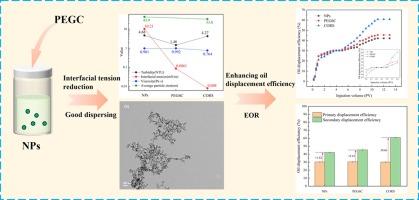用于提高二氧化硅纳米颗粒流体驱油效率的新型聚乙二醇阳离子Gemini表面活性剂
IF 5.9
3区 工程技术
Q1 CHEMISTRY, MULTIDISCIPLINARY
Journal of Industrial and Engineering Chemistry
Pub Date : 2025-04-24
DOI:10.1016/j.jiec.2025.04.040
引用次数: 0
摘要
尽管二氧化硅纳米颗粒(NPs)已经证明了提高原油采收率(EOR)的潜力,但它们的单独应用面临着显著的限制,包括分散性差和界面张力升高。合成了一种聚乙二醇桥接Gemini表面活性剂,并对其界面和乳化性能进行了评价,重点研究了其提高NPs驱油效率的能力。FTIR和1H NMR表征证实了新型Gemini表面活性剂(PEGnC)的成功合成。结果表明,临界胶束浓度(CMC)与隔离剂分子量呈负相关,界面活性随着盐水盐度的增加而增强。PEG6C (600 Da间隔剂)表现出优异的性能,在15 - 25% NaCl浓度下达到了超低的界面张力(10−2-10−3 mN/m),同时表现出最佳的界面活性和乳化能力。将最佳的PEG6C表面活性剂与NPs结合,形成稳定的纳米复合流体,在保持低粘度和浊度的同时,显著降低了界面张力,表现出优异的分散稳定性和界面活性。在NPs液中添加PEG6C可显著提高NPs液的采收率,采收率由11.82%提高到30.66%。这项工作为Gemini表面活性剂与NPs结合开发高性能EOR系统建立了一个有前途的策略。本文章由计算机程序翻译,如有差异,请以英文原文为准。

Novel polyethylene glycol-based cationic Gemini surfactants for enhancing oil displacement efficiency of silica nanoparticles fluids
Although silica nanoparticles (NPs) have demonstrated potential for enhanced oil recovery (EOR), their individual application faces significant limitations including poor dispersion stability and elevated interfacial tension. A polyethylene glycol-bridged Gemini surfactant was synthesized and evaluated for its interfacial and emulsifying properties, with particular emphasis on its ability to enhance the oil displacement efficiency of NPs. FTIR and 1H NMR characterization confirmed the successful synthesis of the novel Gemini surfactants (PEGnC). The results demonstrated an inverse correlation between critical micelle concentration (CMC) and spacer molecular weight, while interfacial activity was enhanced with increasing brine salinity. PEG6C (600 Da spacer) exhibited superior performance, achieving ultra-low interfacial tension (10−2-10−3 mN/m) at 15–25 % NaCl concentrations while demonstrating optimal interfacial activity and emulsification capacity. The optimal PEG6C surfactant was subsequently combined with NPs to formulate a stable nanocomposite fluid, which maintained low viscosity and turbidity while achieving significantly reduced interfacial tension, indicating excellent dispersion stability and interfacial activity. The addition of PEG6C to NPs fluids could significantly improve the oil recovery efficiency of NPs fluids from 11.82 % to 30.66 %. This work establishes a promising strategy for combining Gemini surfactants with NPs to develop high-performance EOR systems.
求助全文
通过发布文献求助,成功后即可免费获取论文全文。
去求助
来源期刊
CiteScore
10.40
自引率
6.60%
发文量
639
审稿时长
29 days
期刊介绍:
Journal of Industrial and Engineering Chemistry is published monthly in English by the Korean Society of Industrial and Engineering Chemistry. JIEC brings together multidisciplinary interests in one journal and is to disseminate information on all aspects of research and development in industrial and engineering chemistry. Contributions in the form of research articles, short communications, notes and reviews are considered for publication. The editors welcome original contributions that have not been and are not to be published elsewhere. Instruction to authors and a manuscript submissions form are printed at the end of each issue. Bulk reprints of individual articles can be ordered. This publication is partially supported by Korea Research Foundation and the Korean Federation of Science and Technology Societies.

 求助内容:
求助内容: 应助结果提醒方式:
应助结果提醒方式:


